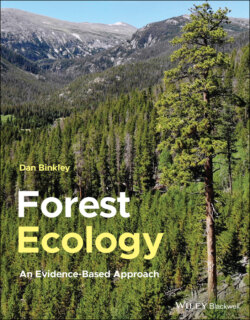Читать книгу Forest Ecology - Dan Binkley - Страница 17
Forests Are Complex Systems That Are Not Tightly Determined
ОглавлениеA core idea in this book is that forests are indescribably complex systems, with an uncountable number of interacting pieces under the influence of external driving factors. Simple stories cannot provide high value for specific cases, because the future development of a forest simply is not constrained enough to allow precise predictions. The good news is that evidence from thousands of research investigations around the world does provide a foundation for useful general insights. The next step is to apply general questions – from the core framework and core methods – to any forest of interest to develop strong, locally relevant knowledge. This book tries to clarify some of the basic nature of forests, and how to rely on evidence as a guide for gauging the amount of confidence warranted in ideas about forests.
A different forest ecology book could be written to summarize what we know about the major features of forests: for a very wide variety of questions, what solid answers emerge for each question from the evidence accumulated over the decades and centuries? That approach would provide a strong reference source for describing the general trends for forests, how variable they are, and what factors account for when forests are likely to be above or below the general trends. The focus of this book is somewhat different, though, as it fosters the thinking and understanding that will provide a strong foundation for adding later evidence found in reference books, journals, and other sources.
The future is not yet written for any forest, and that's also true about this book. If revised editions should appear in the future, they would be much improved by feedback provided by readers of this edition. I gratefully invite feedback about typos, mistakes, omissions, and ideas for how the stories could be stronger and warrant more confidence (Dan.Binkley@alumni.ubc.ca).
The final introductory point is that this book could be rewritten with all of the graphs and all of the examples switched out with different examples from other forests in other locations and other times. For example, sal (Shorea robusta) is a major, important tree in forests across southern Asia (Figure E), but this is the only sentence in the book that mentions sal. Each reader can make use of the book's questions and perspectives by adding local information for other forests types, other places, and other times.
FIGURE E Sal is a major species across southern Asia, just one species of 700 among 16 genera in the Dipterocarp family. Sal wood is valued for lumber, its leaves are used for various purposes (including plates for food), and oil extracted from its seeds are used in food and mechanical applications
(Source: photo by Anand Osuri).
